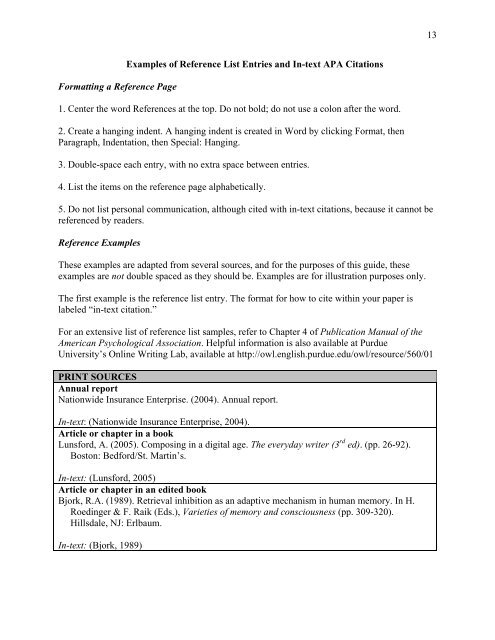What is plagiarism, and why is it important at Franklin ... - My Franklin
What is plagiarism, and why is it important at Franklin ... - My Franklin
What is plagiarism, and why is it important at Franklin ... - My Franklin
- No tags were found...
You also want an ePaper? Increase the reach of your titles
YUMPU automatically turns print PDFs into web optimized ePapers that Google loves.
13<br />
Form<strong>at</strong>ting a Reference Page<br />
Examples of Reference L<strong>is</strong>t Entries <strong>and</strong> In-text APA C<strong>it</strong><strong>at</strong>ions<br />
1. Center the word References <strong>at</strong> the top. Do not bold; do not use a colon after the word.<br />
2. Cre<strong>at</strong>e a hanging indent. A hanging indent <strong>is</strong> cre<strong>at</strong>ed in Word by clicking Form<strong>at</strong>, then<br />
Paragraph, Indent<strong>at</strong>ion, then Special: Hanging.<br />
3. Double-space each entry, w<strong>it</strong>h no extra space between entries.<br />
4. L<strong>is</strong>t the <strong>it</strong>ems on the reference page alphabetically.<br />
5. Do not l<strong>is</strong>t personal communic<strong>at</strong>ion, although c<strong>it</strong>ed w<strong>it</strong>h in-text c<strong>it</strong><strong>at</strong>ions, because <strong>it</strong> cannot be<br />
referenced by readers.<br />
Reference Examples<br />
These examples are adapted from several sources, <strong>and</strong> for the purposes of th<strong>is</strong> guide, these<br />
examples are not double spaced as they should be. Examples are for illustr<strong>at</strong>ion purposes only.<br />
The first example <strong>is</strong> the reference l<strong>is</strong>t entry. The form<strong>at</strong> for how to c<strong>it</strong>e w<strong>it</strong>hin your paper <strong>is</strong><br />
labeled “in-text c<strong>it</strong><strong>at</strong>ion.”<br />
For an extensive l<strong>is</strong>t of reference l<strong>is</strong>t samples, refer to Chapter 4 of Public<strong>at</strong>ion Manual of the<br />
American Psychological Associ<strong>at</strong>ion. Helpful inform<strong>at</strong>ion <strong>is</strong> also available <strong>at</strong> Purdue<br />
Univers<strong>it</strong>y’s Online Wr<strong>it</strong>ing Lab, available <strong>at</strong> http://owl.engl<strong>is</strong>h.purdue.edu/owl/resource/560/01<br />
PRINT SOURCES<br />
Annual report<br />
N<strong>at</strong>ionwide Insurance Enterpr<strong>is</strong>e. (2004). Annual report.<br />
In-text: (N<strong>at</strong>ionwide Insurance Enterpr<strong>is</strong>e, 2004).<br />
Article or chapter in a book<br />
Lunsford, A. (2005). Composing in a dig<strong>it</strong>al age. The everyday wr<strong>it</strong>er (3 rd ed). (pp. 26-92).<br />
Boston: Bedford/St. Martin’s.<br />
In-text: (Lunsford, 2005)<br />
Article or chapter in an ed<strong>it</strong>ed book<br />
Bjork, R.A. (1989). Retrieval inhib<strong>it</strong>ion as an adaptive mechan<strong>is</strong>m in human memory. In H.<br />
Roedinger & F. Raik (Eds.), Varieties of memory <strong>and</strong> consciousness (pp. 309-320).<br />
Hillsdale, NJ: Erlbaum.<br />
In-text: (Bjork, 1989)


